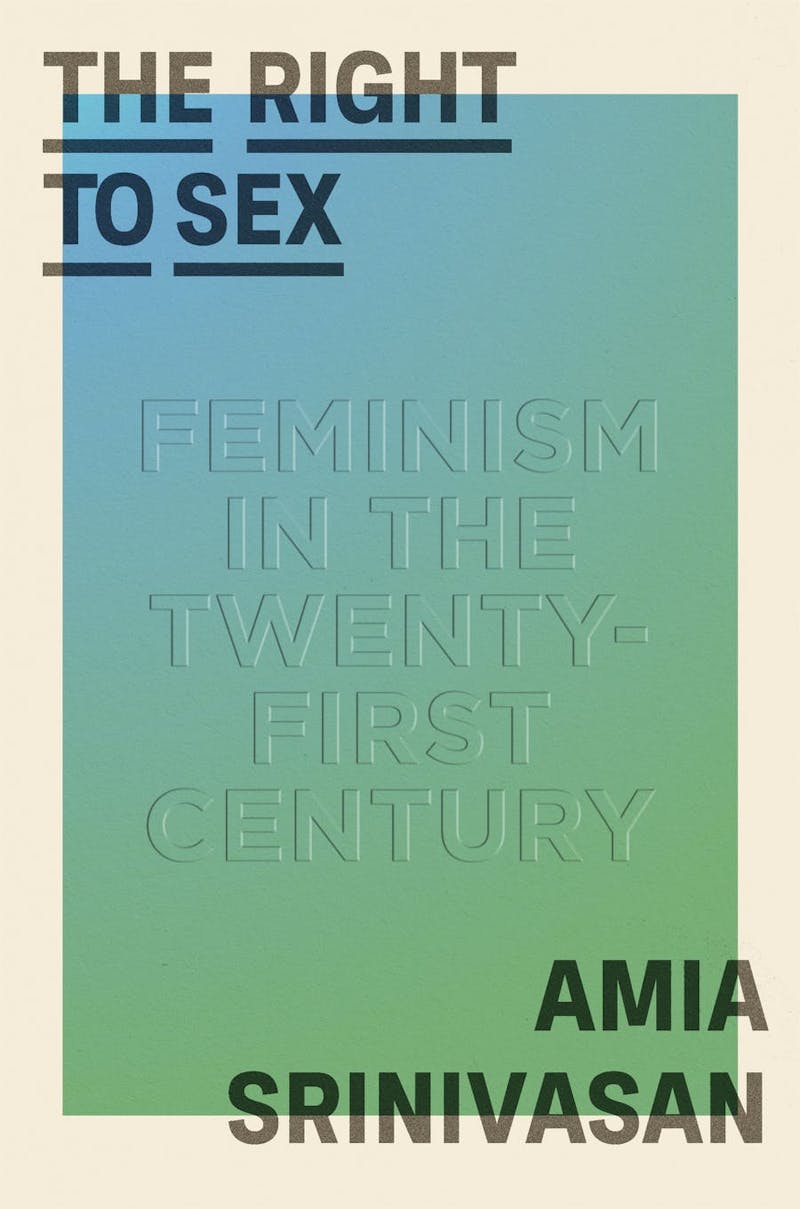“Sex,” the philosopher Amia Srinivasan reminds us, “isn’t a sandwich.” Here she responds to Rebecca Solnit, who in her 2009 essay “Men Explain Lolita to Me,” argued against the misogynist claim that lonely, sex-starved men are being “oppressed” by women who refuse to sleep with them. “You don’t get to share someone’s sandwich unless they want to share their sandwich with you,” wrote Solnit, “and that’s not a form of oppression.” This is certainly true, Srinivasan agrees. But, she asks, what if the situation were—as it often is in life—more complicated than lunch?

Suppose your child came home from primary school and told you that the other children share their sandwiches with each other, but not with her. And suppose further that your child is brown, or fat, or disabled, or doesn’t speak English very well, and that you suspect this is the reason for her exclusion from the sandwich-sharing. Suddenly it hardly seems sufficient to say that none of the other children is obliged to share with your child, true as that might be.
This passage is from Srinivasan’s essay “Does Anyone Have the Right to Sex?” which first appeared in the London Review of Books in 2018 and is now out as part of a collection. In the six essays contained within The Right to Sex, Srinivasan covers a lot of ground: pornography, sex work, Title IX, #MeToo, the racial politics of desirability, the incel movement, student-teacher relationships, carceral feminism; even Tila Tequila gets a cameo. If the collection has any through line, it is dissatisfaction. Srinivasan diagnoses a certain degree of incuriosity at the heart of mainstream feminism, particularly as it relates to sex. She worries, for instance, about our overreliance on consent as a rubric to navigate the moral landscape of desire: “Sex is no longer morally problematic or unproblematic: it is instead merely wanted or unwanted.” Elsewhere, she finds that in our rush for answers about how to manage sex on college campuses, we have forgotten to formulate the right questions. In “On Not Sleeping With Your Students,” Srinivasan (who teaches Social and Political Theory at Oxford) asks, “Is it too sterile, too boring to suggest that instead of sleeping with his student, this professor should have been—teaching her?”
This all might sound dizzying, even overwhelming, but Srinivasan lays out the stakes of these questions with an urgency that forces you to stay with her, to live in the difficulty of the politically inconvenient. “These essays do not offer a home,” she warns, but instead “dwell, where necessary, in discomfort and ambivalence.” This homelessness might leave some readers of The Right to Sex feeling unsated, hungry for clearer choices about how to live a feminist life. Well, that is the point. If the current state of popular, celebrity-adjacent feminism has not likewise left you feeling starved, it is probably because you are filled up on the wrong thing: easy analogies about sandwiches and other empty calories of discourse.
The title, The Right to Sex, is tongue in cheek. It derives from Srinivasan’s observations of the incel (involuntarily celibate) movement and its most infamous representative, Elliot Rodger, the perpetrator of the 2014 Isla Vista killings. On May 23, 2014, the 22-year-old Rodger murdered six men and women near the campus of the University of California–Santa Barbara, targeting the Alpha Phi sorority house. In a 107,000-word manifesto titled “My Twisted World: The Story of Elliot Rodger,” he expressed his desire to punish “hot blondes” who had rejected him. The feminist response, which crystallized around the hashtag #YesAllWomen, focused on consciousness-raising around male sexual entitlement, including its new digital manifestation within an online community of men like Rodger who called themselves “incels.”
There was more, though, to that manifesto, notes Srinivasan, like the accusation leveled by Rodger—who is half-white, half–Malaysian Chinese—that he had been sexually rejected on the basis of race and for a tendency toward introversion that clashed with the alpha male ideal. Despite the undeniably horrific nature of his actions, says Srinivasan, the “kind of diagnosis Rodger offered, in which racism and the norms of hetero-masculinity placed him beyond desirability, need not in principle be wrong.” What concerned Srinivasan was the response from feminists and how, in a rush to—rightly—condemn Rodger, many found themselves rhetorically depoliticizing sex instead of “dwell[ing] in the ambivalent place where we acknowledge that no one is obliged to desire anyone else, that no one has a right to be desired, but also that who is desired and who isn’t is a political question, a question often answered by more general patterns of domination and exclusion.”
To that end, Srinivasan details the proliferation of sexual racism as seen on dating apps, where tags like “NO DICKS, NO FEMS, NO FATS, NO BLACKS, NO ARABS, NO RICE NO SPICE, MASC-For -MASC” are common. As people announce the broad categories they want to exclude from their dating pool, Srinivasan notes the “racism, ableism, transphobia and every other oppressive system that makes its way into the bedroom through the seemingly innocuous mechanism of ‘personal preference.’” There is nothing personal about this, Srinivasan pushes back, arguing in favor of a political framing of sexual desire that takes into account the forces of colonialism and white supremacy in shaping standards of physical attractiveness or of who possesses “fuckability” (fuckability, she explains, refers not to sexualized bodies but rather those bodies that “confer status on those who have sex with them”). Srinivasan sees in contemporary feminist discourse a reticence to politicize desire, a hesitation she associates with the predominance of sex positivity and the hallowed status of consent: “When we see consent as the sole constraint on ethically okay sex, we are pushed towards a naturalization of sexual preferences.”
In another essay, “Coda: The Politics of Desire,” Srinivasan responds to readers of 2018’s “Does Anyone Have the Right to Sex?” addressing tweets, emails, and other words of support (and rancor) she received after it came out in the LRB. Across these essays, it should be said, Srinivasan is democratically dialogic; she responds in equal measure to comments made by students during office hours, emails from strangers who found her work online, and critiques from well-known writers and feminist scholars. One of the more fascinating exchanges she engages in in “Coda” is with Andrea Long Chu. On an episode of The Point magazine’s podcast, when asked by host Anastasia Berg to comment on “The Right to Sex,” Chu acknowledged the validity of Srinivasan’s inquiry but expressed concern at where such thinking might leave us if we pursued it to its logical conclusion. “It’s really fucking hard to figure out a way to tell people to change their desires that isn’t moralistic,” said Chu, “and that isn’t actually about doing the same kind of thing to desire that supposedly queer politics was supposed to be against in the first place.” To imagine desire as a construct, Chu argues, is to suggest, on some level, that it could be easily remade, reordered, channeled elsewhere—and who would decide where?
Yet, as Srinivasan reminds us, queer politics was as inquisitive as it was affirming. It asked us to be curious about desire and suspicious of the social cues telling us that we all want the same thing. “Is there no difference,” she challenges Chu, “between ‘telling people to change their desires’ and asking ourselves what we want, why we want it, and what it is we want to want?”
Reading this back and forth, I wondered if it really is true that feminists, in the name of sex positivity, have inadvertently shielded desire from political inquiry. Colorism is a dominant theme in Black life and has certainly been an object of Black feminist scrutiny, both in academia and on social media. Recently, scholars like Genevieve Clutario at Wellesley College and Dredge Kang at the University of California–San Diego have explored the currency of whiteness within Asian beauty cultures.
These examples do not refute Srinivasan’s claim as much as they helped explain for me why she might have chosen Rodgers as a case study. Where did our rich vocabulary and critical frameworks for the politics of desire disappear at that moment? The answer is obvious. In the midst of #YesAllWomen, to speak of the racial specificity of Rodger’s targets—“hot blonde sluts,” would have felt icky or worse—would have been taken out of context to suggest nonwhite women do not experience sexual violence, which is obviously not true. Yet Srinivasan warns us against letting the fear of misunderstanding get in the way of saying what needs to be said. “A truly inclusionary politics,” she writes, “is an uncomfortable, unsafe politics.”
Each individual essay in this collection is complex, requiring an exegesis beyond what the scope of a single book review can handle, but certain moments stand out to me as impossible not to highlight. In “The Conspiracy Against Men,” her essay on #MeToo, Srinivasan takes on fears of false allegations and the outsize space that they take up in public discussions of rape and sexual harassment. She raises a number of provocative points, but one that strikes as particularly poignant is her theory that fears of false accusations stem from “an anxiety, too, about race and class: about the possibility that the law might treat wealthy white men as it routinely treats poor black and brown men.” In “Talking to My Students About Porn,” she revisits the ideas and legislative agitation of anti-porn feminists like Catherine MacKinnon and Andrea Dworkin. To Srinivasan’s great surprise, her students were “riveted,” finding in these writings a kind of recognition that sex positivity had not translated into sexual freedom but, rather, new and unattainable expectations.
This essay has drawn criticism, with some accusing Srinivasan of trying to rehabilitate MacKinnon, who just last week published an op-ed in The New York Times calling the site OnlyFans a “pimp.” Yet I felt that Srinivasan was careful to disentangle ideas from action, and laid out some startling information about the unequal policing of pornography and sex work. In Australia, she notes, there is a ban on possession and dissemination of porn in the Northern Territories occupied by Aborigine communities, and yet “there is no ban on the consumption of pornography by white Australians.” In another essay, “Sex, Carceralism, and Capitalism,” Srinivasan fleshes this out more, expressing concern with the litigiousness of the #MeToo movement and its intimacy with a criminal justice system that has historically produced inequitable outcomes for people of color. “A feminist politics which sees the punishment of bad men as its primary purpose,” she urges, “will never be a feminism that liberates all women, for it obscures what makes most women unfree.”
I took a class on feminism in college where the professor made us argue a point of view on a particular issue, then argue against it. The measure of our performance would be that we approached both with equal rigor, that we showed some evidence of being convinced each time. Reading The Right to Sex reminded me of that assignment. On any given page, Srinivasan will leave you feeling convinced she has found a way out, only to pull the rug out from under you; whenever she says “but,” one wants to duck. Though far from exasperation, I felt relieved—even hopeful—that someone is asking the hard questions in public without asking for anything as absurd as a single answer.








